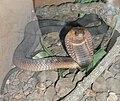Reptile
Reptile is the common name for one of the main groups of land vertebrates. It is not used so much by biologists, who use more accurate terms.
| Reptiles Temporal range: Carboniferous – Recent
| |
|---|---|

| |
| A Tuatara, Sphenodon punctatus | |
| Scientific classification | |
| Kingdom: | |
| Phylum: | |
| Class: | Goodrich, 1916
|
| Living orders | |
| Synonyms | |
| |

The name "reptile" comes from Latin and means "one who creeps". All living reptile species are cold blooded, have scaly skin, and lay cleidoic eggs.[1][2] They excrete uric acid (instead of urea), and have a cloaca. A cloaca is a shared opening for the anus, urinary tract and reproductive ducts. Reptiles also share an arrangement of the heart and major blood vessels which is different from that of mammals.[3]
Many important groups of reptiles are now extinct. The great marine reptiles of the Mesozoic era, the ichthyosaurs, plesiosaurs and mosasaurs, are extinct. We used to say the dinosaurs were extinct, but they survive in the form of their feathered descendents (birds). Ancient reptiles that do survive include the turtles, the crocodiles and the Tuatara, the lone survivor of its group. The great majority of present-day reptiles are snakes and lizards.
The study of living reptiles is called herpetology.
Birds in relation to reptiles
Some reptiles are more closely related to birds than they are to other reptiles. Crocodiles are more closely related to birds than they are to lizards. Theropod dinosaurs are even more closely related, because birds evolved from them.
Cladistic writers prefer a more unified (monophyletic) grouping. This puts the birds (over 10,000 species) with what people normally call reptiles.[4][5][6] (see Sauropsida)
Taxonomy
Reptilia is an evolutionary grade rather than a clade. The main reason is that the term 'reptile' does not include birds, the descendents of theropod dinosaurs. Another reason is that the word 'reptile' is misleading because many extinct types were very different from living reptiles.
So instead of Reptilia as a taxonomic class, today most experts use Class Sauropsida (which includes all reptiles and birds, living and extinct). Class Synapsida includes mammals and all their forebears. Reptile is still the usual informal term to describe living snakes and lizards. Mammals are a genuine clade, and so Mammalia is still the taxonomic term.
Since reptiles are not monophyletic, reclassifying them is one of the key aims of researchers.[4][7][8] Some taxonomists, such as Benton,[9] make Sauropsida and Synapsida as class-level taxa. The two groups split in the Carboniferous, from stem-group Amniotes (the early tetrapods, which laid cleidoic eggs).
Living reptiles
- Reptiles (living groups only)
- Order Crocodilia (crocodiles, gavials, caimans, and alligators): 23 species
- Order Sphenodontia (Tuatara from New Zealand): 2 species
- Order Squamata (lizards, snakes, and amphisbaenids ("worm-lizards"): about 7,000 species.
- Order Testudines (turtles, tortoises, and terrapins): approximately 300 species
Chameleons, a lizard
Komodo dragon, sleeping. Largest living lizard
References
| Wikispecies has information on: Reptilia. |
| Wikimedia Commons has media related to Lua error in Module:Commons_link at line 62: attempt to index field 'wikibase' (a nil value).. |
- ↑ Some give birth to live young, with the cleidoic eggs developing internally.
- ↑ 2008. "Squamata Suborder: Serpentes". The University of Georgia Museum of Natural History. [1]
- ↑ Goodrich E.S. 1930. Studies on the structure and development of Vertebrates. Macmillan, London.
- ↑ 4.0 4.1 Gauthier J.A., Kluge A.G & Rowe T. 1988. The early evolution of the Amniota. pp103–155 in Michael J. Benton (ed) The phylogeny and classification of the tetrapods, Volume 1: Amphibians, Reptiles, Birds. Systematics Association, Special vol 35A. Clarendon Press, Oxford.
- ↑ Laurin, M. (1995). "A reevaluation of early amniote phylogeny" (PDF). Zoological Journal of the Linnean Society. 113 (2): 165–223. doi:10.1111/j.1096-3642.1995.tb00932.x.
{{cite journal}}: Unknown parameter|coauthors=ignored (|author=suggested) (help) - ↑ Modesto, S.P. (1999). "Observations of the structure of the Early Permian
reptile Stereosternum tumidum Cope". Palaeontologia Africana. 35: 7–19.
{{cite journal}}: line feed character in|title=at position 51 (help) - ↑ Gauthier J.A. 1994. The diversification of the amniotes. In D.R. Prothero and R.M. Schoch (eds) Major features of vertebrate evolution. 129-159. Knoxville, Tennessee: The Paleontological Society.
- ↑ Laurin M. & Gauthier J.A. 1996. Amniota, Mammals, reptiles (turtles, lizards, Sphenodon, crocodiles, birds) and their extinct relatives. Version 01 January 1996. The Tree of Life Web Project.
- ↑ Benton, Michael J. 2004. Vertebrate Paleontology. 3rd ed, Blackwell, Oxford. ISBN 0-632-05637-1.





